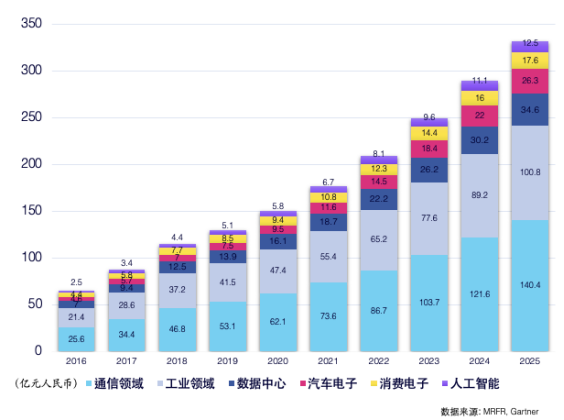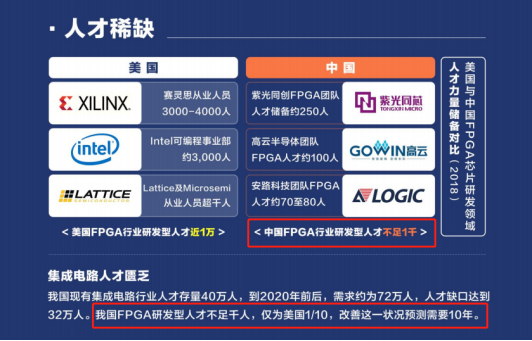Why learn FPGA? Is it due to its broad prospects? Attractive salaries? Avoiding midlife crises? Strong national policy support? Or contributing to the country’s technological development?
Everyone has different reasons for choosing to learn FPGA, but they often revolve around these aspects. According to a survey by Chengdian Guoxin for students learning FPGA, the reasons for learning FPGA generally fall into the following categories.
1. FPGA Technology Has Advantages
FPGA is a product developed further on the basis of programmable devices such as PAL and GAL. It emerged as a semi-custom circuit in the field of application-specific integrated circuits (ASIC), solving the shortcomings of custom circuits and overcoming the limitation of the number of logical gates in existing programmable devices.

FPGA consists of hardware resources such as logic units, RAM, and multipliers. By organizing these hardware resources properly, hardware circuits such as multipliers, registers, and address generators can be realized.
FPGA Technology Has Stability. Software tools provide a programming environment, and FPGA circuits are a true programming “hard” execution process. Systems based on processors often contain multiple layers of abstraction and can schedule tasks and share resources among multiple processes.
In terms of performance, utilizing the advantages of hardware parallelism, FPGA breaks the sequential execution model, completing more processing tasks within each clock cycle, surpassing the computational capabilities of DSPs.
Relatively low cost, with less long-term maintenance investment. FPGA chips are field-upgradable, eliminating the time and cost involved in redesigning ASICs.
2. FPGA Industry Has Great Prospects
With the rapid development of artificial intelligence, cloud services, data centers, 5G, and autonomous driving, the application of FPGA is becoming increasingly widespread.
The flexible and efficient, reprogrammable characteristics of FPGA allow it to play an important role in these fields.
At the same time, the FPGA industry is also growing at an astonishing rate, especially in China, where the FPGA market is growing at a rate of 30% per year.

3. Strong National Policy Support
As one of the four major general-purpose integrated circuit chips, the importance of FPGA is self-evident. As cloud computing, big data, artificial intelligence, 5G, and industrial IoT become hot topics, FPGA plays an irreplaceable role in these fields.
The country has already classified FPGA as a national strategic chip and has introduced a series of policy measures to support the development of the FPGA industry. These measures include financial support, tax incentives, and talent introduction.
In recent years, the development trend of the integrated circuit industry in our country has been good. This July, various regions successively revealed their economic semi-annual reports, and the progress of the integrated circuit industry was particularly noteworthy.
According to the National Bureau of Statistics, the output of integrated circuit products nationwide increased by 28.9% year-on-year in the first half of the year. The output value of integrated circuits in major cities like Beijing, Shanghai, Guangzhou, and Chongqing has seen double-digit year-on-year growth.

4. There Is A Large Talent Gap In The FPGA Industry
With the rapid development of the FPGA industry, the talent shortage issue is becoming increasingly prominent.
Currently, the global FPGA market size has reached the tens of billions of dollars, but the supply of professional FPGA talent is insufficient.
In China, although the talent reserve in the integrated circuit industry has reached 400,000, the number of professional FPGA talents is less than a few thousand.

Therefore, learning FPGA not only helps personal career development but also contributes to the country’s technological advancement.
If in the United States, either high salaries are spent to dig talents from big companies like Apple, or looking for engineers in their fifties or sixties.
In our country, even though there is serious competition, there is still a saying in the industry: in the software industry, 35 is considered old, while in hardware, 53 is still splendid.
Getting started with FPGA is actually not as difficult as imagined. With a certain foundation in digital integrated circuits and professional systematic FPGA introductory courses, it only takes about four months to become a junior FPGA engineer.

Chengdian Guoxin has focused on the research and development of FPGA courses for six years, with independently developed tutorials that are gradual and case-guided, making them more suitable for beginners with no foundation.
Focusing on FPGA talent cultivation and output, oriented towards engineering, driving innovation through practical operations, significantly shortens the time for FPGA talent training.
Students interested in learning about FPGA courses are welcome to consult Chengdian Guoxin.
Since you’ve read this far, give us a follow!!
Click the image to follow the “Chengdian Guoxin FPGA Talent Training” mini program/service account
For more information, consult:















